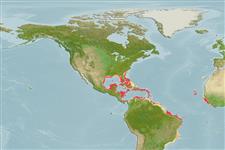>
Anguilliformes (Eels and morays) >
Muraenidae (Moray eels) > Muraeninae
Etymology: Gymnothorax: Greek, gymnos = naked + Greek, thorax, -akos = breast (Ref. 45335).
More on author: Kaup.
Environment: milieu / climate zone / rango de profundidad / distribution range
Ecología
marino asociado a arrecife; rango de profundidad 0 - 60 m (Ref. 9710), usually 0 - 35 m (Ref. 40849). Subtropical; 41°N - 26°S, 99°W - 5°W
Western Atlantic: Bermuda and southern Florida, USA to the Antilles (Ref. 26340) and southeast Brazil (Ref. 42064). Eastern Atlantic: St. Paul's Rocks (Ref. 13121), Cape Verde, Ascension and St. Helena islands (Ref. 4450). Also mid-Atlantic islands (Ref. 26938).
Tamaño / Peso / Age
Madurez: Lm ? range ? - ? cm
Max length : 70.0 cm TL macho / no sexado; (Ref. 4450); common length : 40.0 cm TL macho / no sexado; (Ref. 5217)
Dark brown with numerous yellow dots, smallest on head and largest toward end of tail where they are irregular and confluent (Ref. 13442). Stout moray with a short blunt snout. Tip of tail always pale, usually deep yellow in life. Posterior nostril in short tube (Ref. 26938).
Body shape (shape guide): eel-like.
A benthic and solitary species (Ref. 26340) inhabiting coral reefs and rocky shorelines. Usually at depths of 60 m (Ref. 26938). One of the most common and easily recognized morays of the West Indian reefs, active during the day and sometimes hunting together with other predators (Ref. 42064). This species has been called Muraena miliaris (Ref. 26938).
Life cycle and mating behavior
Madurez | Reproducción | Puesta | Huevos | Fecundidad | Larva
Robins, C.R., R.M. Bailey, C.E. Bond, J.R. Brooker, E.A. Lachner, R.N. Lea and W.B. Scott, 1991. Common and scientific names of fishes from the United States and Canada. Am. Fish. Soc. Spec. Publ. (20):183 p. (Ref. 3814)
IUCN Red List Status (Ref. 130435: Version 2025-1)
Threat to humans
Harmless
Human uses
Pesquerías: escaso valor comercial; Acuario: Comercial
Herramientas
Special reports
Download XML
Fuentes de Internet
Estimates based on models
Preferred temperature (Referencia
123201): 24.6 - 28, mean 27 °C (based on 498 cells).
Phylogenetic diversity index (Referencia
82804): PD
50 = 0.5000 [Uniqueness, from 0.5 = low to 2.0 = high].
Bayesian length-weight: a=0.00098 (0.00061 - 0.00157), b=3.24 (3.11 - 3.37), in cm total length, based on LWR estimates for this species & Genus-body shape (Ref.
93245).
Nivel trófico (Referencia
69278): 3.9 ±0.63 se; based on food items.
Resiliencia (Referencia
120179): Medio, población duplicada en un tiempo mínimo de 1.4-4.4 años (Preliminary K or Fecundity.).
Fishing Vulnerability (Ref.
59153): Moderate to high vulnerability (48 of 100).
🛈
Nutrients (Ref.
124155): Calcium = 21.5 [10.4, 54.2] mg/100g; Iron = 0.462 [0.251, 0.942] mg/100g; Protein = 19.4 [17.2, 21.9] %; Omega3 = 0.172 [0.073, 0.489] g/100g; Selenium = 20 [10, 43] μg/100g; VitaminA = 42 [12, 149] μg/100g; Zinc = 0.652 [0.423, 0.992] mg/100g (wet weight);
